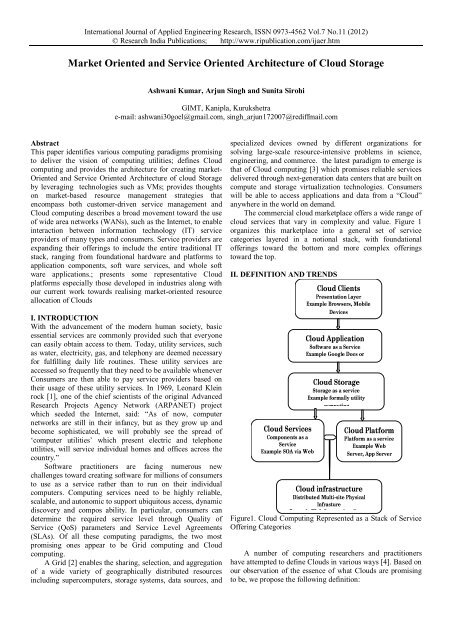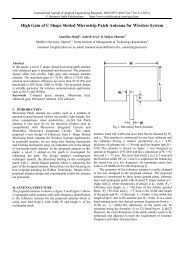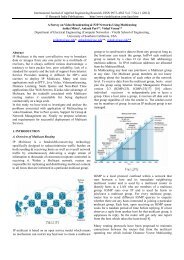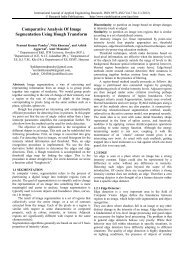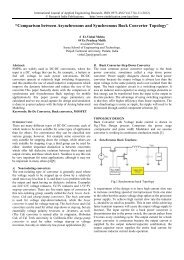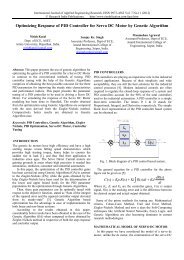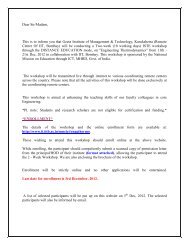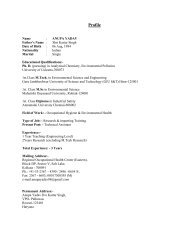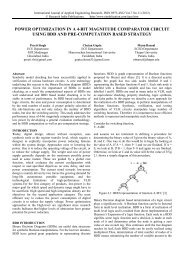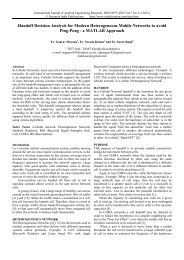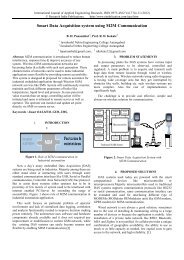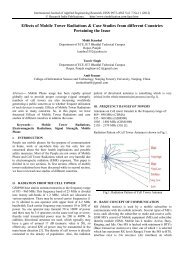Market Oriented and Service Oriented Architecture of Cloud Storage
Market Oriented and Service Oriented Architecture of Cloud Storage
Market Oriented and Service Oriented Architecture of Cloud Storage
You also want an ePaper? Increase the reach of your titles
YUMPU automatically turns print PDFs into web optimized ePapers that Google loves.
International Journal <strong>of</strong> Applied Engineering Research, ISSN 0973-4562 Vol.7 No.11 (2012)<br />
© Research India Publications; http://www.ripublication.com/ijaer.htm<br />
<strong>Market</strong> <strong>Oriented</strong> <strong>and</strong> <strong>Service</strong> <strong>Oriented</strong> <strong>Architecture</strong> <strong>of</strong> <strong>Cloud</strong> <strong>Storage</strong><br />
Ashwani Kumar, Arjun Singh <strong>and</strong> Sunita Sirohi<br />
GIMT, Kanipla, Kurukshetra<br />
e-mail: ashwani30goel@gmail.com, singh_arjun172007@rediffmail.com<br />
Abstract<br />
This paper identifies various computing paradigms promising<br />
to deliver the vision <strong>of</strong> computing utilities; defines <strong>Cloud</strong><br />
computing <strong>and</strong> provides the architecture for creating market-<br />
<strong>Oriented</strong> <strong>and</strong> <strong>Service</strong> <strong>Oriented</strong> <strong>Architecture</strong> <strong>of</strong> cloud <strong>Storage</strong><br />
by leveraging technologies such as VMs; provides thoughts<br />
on market-based resource management strategies that<br />
encompass both customer-driven service management <strong>and</strong><br />
<strong>Cloud</strong> computing describes a broad movement toward the use<br />
<strong>of</strong> wide area networks (WANs), such as the Internet, to enable<br />
interaction between information technology (IT) service<br />
providers <strong>of</strong> many types <strong>and</strong> consumers. <strong>Service</strong> providers are<br />
exp<strong>and</strong>ing their <strong>of</strong>ferings to include the entire traditional IT<br />
stack, ranging from foundational hardware <strong>and</strong> platforms to<br />
application components, s<strong>of</strong>t ware services, <strong>and</strong> whole s<strong>of</strong>t<br />
ware applications.; presents some representative <strong>Cloud</strong><br />
platforms especially those developed in industries along with<br />
our current work towards realising market-oriented resource<br />
allocation <strong>of</strong> <strong>Cloud</strong>s<br />
I. INTRODUCTION<br />
With the advancement <strong>of</strong> the modern human society, basic<br />
essential services are commonly provided such that everyone<br />
can easily obtain access to them. Today, utility services, such<br />
as water, electricity, gas, <strong>and</strong> telephony are deemed necessary<br />
for fulfilling daily life routines. These utility services are<br />
accessed so frequently that they need to be available whenever<br />
Consumers are then able to pay service providers based on<br />
their usage <strong>of</strong> these utility services. In 1969, Leonard Klein<br />
rock [1], one <strong>of</strong> the chief scientists <strong>of</strong> the original Advanced<br />
Research Projects Agency Network (ARPANET) project<br />
which seeded the Internet, said: “As <strong>of</strong> now, computer<br />
networks are still in their infancy, but as they grow up <strong>and</strong><br />
become sophisticated, we will probably see the spread <strong>of</strong><br />
‘computer utilities’ which present electric <strong>and</strong> telephone<br />
utilities, will service individual homes <strong>and</strong> <strong>of</strong>fices across the<br />
country.”<br />
S<strong>of</strong>tware practitioners are facing numerous new<br />
challenges toward creating s<strong>of</strong>tware for millions <strong>of</strong> consumers<br />
to use as a service rather than to run on their individual<br />
computers. Computing services need to be highly reliable,<br />
scalable, <strong>and</strong> autonomic to support ubiquitous access, dynamic<br />
discovery <strong>and</strong> compos ability. In particular, consumers can<br />
determine the required service level through Quality <strong>of</strong><br />
<strong>Service</strong> (QoS) parameters <strong>and</strong> <strong>Service</strong> Level Agreements<br />
(SLAs). Of all these computing paradigms, the two most<br />
promising ones appear to be Grid computing <strong>and</strong> <strong>Cloud</strong><br />
computing.<br />
A Grid [2] enables the sharing, selection, <strong>and</strong> aggregation<br />
<strong>of</strong> a wide variety <strong>of</strong> geographically distributed resources<br />
including supercomputers, storage systems, data sources, <strong>and</strong><br />
specialized devices owned by different organizations for<br />
solving large-scale resource-intensive problems in science,<br />
engineering, <strong>and</strong> commerce. the latest paradigm to emerge is<br />
that <strong>of</strong> <strong>Cloud</strong> computing [3] which promises reliable services<br />
delivered through next-generation data centers that are built on<br />
compute <strong>and</strong> storage virtualization technologies. Consumers<br />
will be able to access applications <strong>and</strong> data from a “<strong>Cloud</strong>”<br />
anywhere in the world on dem<strong>and</strong>.<br />
The commercial cloud marketplace <strong>of</strong>fers a wide range <strong>of</strong><br />
cloud services that vary in complexity <strong>and</strong> value. Figure 1<br />
organizes this marketplace into a general set <strong>of</strong> service<br />
categories layered in a notional stack, with foundational<br />
<strong>of</strong>ferings toward the bottom <strong>and</strong> more complex <strong>of</strong>ferings<br />
toward the top.<br />
II. DEFINITION AND TRENDS<br />
<strong>Cloud</strong> <strong>Service</strong>s<br />
Components as a<br />
<strong>Service</strong><br />
Example SOA via Web<br />
<strong>Service</strong> st<strong>and</strong>ards<br />
<strong>Cloud</strong> Clients<br />
Presentation Layer<br />
Example Browsers, Mobile<br />
Devices<br />
<strong>Cloud</strong> Application<br />
S<strong>of</strong>tware as a <strong>Service</strong><br />
Example Google Docs or<br />
Calendar<br />
<strong>Cloud</strong> <strong>Storage</strong><br />
<strong>Storage</strong> as a service<br />
Example formally utility<br />
computing<br />
<strong>Cloud</strong> infrastructure<br />
Distributed Multi-site Physical<br />
Infrasture<br />
<strong>Cloud</strong> Platform<br />
Platform as a service<br />
Example Web<br />
Server, App Server<br />
Example Web Server, App Server<br />
Figure1. <strong>Cloud</strong> Computing Represented as a Stack <strong>of</strong> <strong>Service</strong><br />
Offering Categories<br />
A number <strong>of</strong> computing researchers <strong>and</strong> practitioners<br />
have attempted to define <strong>Cloud</strong>s in various ways [4]. Based on<br />
our observation <strong>of</strong> the essence <strong>of</strong> what <strong>Cloud</strong>s are promising<br />
to be, we propose the following definition:
International Journal <strong>of</strong> Applied Engineering Research, ISSN 0973-4562 Vol.7 No.11 (2012)<br />
© Research India Publications; http://www.ripublication.com/ijaer.htm<br />
"A <strong>Cloud</strong> is a type <strong>of</strong> parallel <strong>and</strong> distributed system<br />
consisting <strong>of</strong> a collection <strong>of</strong> interconnected<br />
<strong>and</strong> virtualised computers that are dynamically provisioned<br />
<strong>and</strong> presented as one or more unified computing resources<br />
based on service-level agreements established through<br />
negotiation between the service provider <strong>and</strong> consumers.”<br />
2.1 WEB SEARCH TRENDS<br />
The popularity <strong>of</strong> different paradigms varies with time. The<br />
Web search popularity, as measured by the Google search<br />
trends during the last 12 months, for terms “cluster<br />
computing”, “Grid computing”, <strong>and</strong> “<strong>Cloud</strong> computing” is<br />
shown in Figure 2. From the Google trends, it can be observed<br />
that cluster computing was a popular term during 1990s, from<br />
early 2000 Grid computing become popular, <strong>and</strong> recently<br />
<strong>Cloud</strong> computing started gaining popularity.<br />
Figure 3: High-level market-oriented cloud architecture.<br />
Figure 2: Google search trends for the last 12 months.<br />
III. MARKET-ORIENTED CLOUD ARCHITECTURE<br />
As consumers will require specific QoS to be maintained by<br />
their providers in order to meet their objectives <strong>and</strong> sustain<br />
their operations. <strong>Cloud</strong> providers will need to consider <strong>and</strong><br />
meet different QoS parameters <strong>of</strong> each individual consumer as<br />
negotiated in specific SLAs, <strong>Cloud</strong> providers can no longer<br />
continue to deploy traditional system-centric resource<br />
management architecture that do not provide incentives for<br />
them to share their resources <strong>and</strong> still regard all service<br />
requests to be <strong>of</strong> equal importance. Instead, market-oriented<br />
resource management [5] is necessary to regulate the supply<br />
<strong>and</strong> dem<strong>and</strong> <strong>of</strong> <strong>Cloud</strong> resources at market equilibrium, provide<br />
feedback in terms <strong>of</strong> economic incentives for both <strong>Cloud</strong><br />
consumers <strong>and</strong> providers, <strong>and</strong> promote QoS-based resource<br />
allocation mechanisms that differentiate service requests based<br />
on their utility.<br />
Figure 3 shows the high-level architecture for supporting<br />
market-oriented resource allocation in Data Centres <strong>and</strong><br />
<strong>Cloud</strong>s. There are basically four main entities involved:<br />
Users/Brokers: Users or brokers acting on their behalf<br />
submit service requests from anywhere in the world to the<br />
Data Centre <strong>and</strong> <strong>Cloud</strong> to be processed.<br />
SLA Resource Allocator: The SLA Resource Allocator<br />
acts as the interface between the Data Centre/<strong>Cloud</strong><br />
service provider external users/brokers.<br />
<br />
<br />
VMs: Multiple VMs can be started <strong>and</strong> stopped<br />
dynamically on a single physical machine to meet<br />
accepted service requests, hence providing maximum<br />
flexibility to configure various partitions <strong>of</strong> resources on<br />
the same physical machine to different specific<br />
requirements <strong>of</strong> service requests. In addition, multiple<br />
VMs can concurrently run applications based on different<br />
operating system environments on a single physical<br />
machine since every VM is completely isolated from one<br />
another on the same physical machine.<br />
Physical Machines: The Data Centre comprises multiple<br />
computing servers that provide resources to meet service<br />
dem<strong>and</strong>s.<br />
3.1 Comparing <strong>Cloud</strong> Computing <strong>and</strong> SOA:<br />
<strong>Cloud</strong> computing <strong>and</strong> SOA have important overlapping<br />
concerns <strong>and</strong> common considerations, as shown in Figure 4.<br />
The most important overlap occurs near the top <strong>of</strong> the cloud<br />
computing stack, in the area <strong>of</strong> <strong>Cloud</strong> <strong>Service</strong>s, which are<br />
network accessible application components <strong>and</strong> s<strong>of</strong>t ware<br />
services, such as contemporary Web <strong>Service</strong>s. (See the<br />
notional cloud stack in Figure 1.)<br />
Both cloud computing <strong>and</strong> SOA share concepts <strong>of</strong> service<br />
orientation.[6] <strong>Service</strong>s <strong>of</strong> many types are available on a<br />
common network for use by consumers. <strong>Cloud</strong> computing<br />
focuses on turning aspects <strong>of</strong> the IT computing stack into<br />
commodities[7] , that can be purchased incrementally from the<br />
cloud based providers <strong>and</strong> can be considered a type <strong>of</strong><br />
outsourcing in many cases. For example, large-scale online<br />
storage can be procured <strong>and</strong> automatically allocated in<br />
terabyte units from the cloud. Similarly, a platform to operate<br />
web-based applications can be rented from redundant data<br />
centres in the cloud. However, cloud computing is currently a<br />
broader term than SOA <strong>and</strong> covers the entire stack from<br />
hardware through the presentation layer s<strong>of</strong>t ware systems.<br />
SOA, though not restricted conceptually to s<strong>of</strong>t ware, is <strong>of</strong>t en<br />
implemented in practice as components or s<strong>of</strong>t ware services,
International Journal <strong>of</strong> Applied Engineering Research, ISSN 0973-4562 Vol.7 No.11 (2012)<br />
© Research India Publications; http://www.ripublication.com/ijaer.htm<br />
as exemplified by the Web <strong>Service</strong> st<strong>and</strong>ards used in many<br />
implementations. These components can be tied together <strong>and</strong><br />
executed on many platforms across the network to provide a<br />
business function.<br />
3.2 Can SOA Be Skipped for <strong>Cloud</strong> Computing<br />
SOA <strong>and</strong> cloud computing are complementary activities <strong>and</strong><br />
both will play important roles in IT planning for senior<br />
leadership teams for years to come. <strong>Cloud</strong> computing <strong>and</strong><br />
SOA can be pursued independently, or concurrently, where<br />
cloud computing platform <strong>and</strong> storage service <strong>of</strong>ferings can<br />
provide a value-added underpinning for SOA efforts. John<br />
Foley describes cloud computing as “on-dem<strong>and</strong> access to<br />
virtualized IT resources that are housed outside <strong>of</strong> your own<br />
data centre, shared by others, simple to use, paid for via<br />
subscription, <strong>and</strong> accessed over the Web.”[8]<br />
IV. STANDARDIZING CLOUD COMPUTING<br />
INTERFACES<br />
In a programmable interface to the IaaS infrastructure means<br />
that you can write client s<strong>of</strong>tware that uses this interface to<br />
manage your use <strong>of</strong> the <strong>Cloud</strong>. Many cloud providers have<br />
licensed their proprietary APIs freely allowing anyone to<br />
implement a similar cloud infrastructure. Despite the<br />
accessibility <strong>of</strong> open APIs, cloud community members have<br />
been slow to uniformly adopt any proprietary interface<br />
controlled by a single company. The Open Source community<br />
has attempted responses, but this has done little to stem the<br />
tide <strong>of</strong> API proliferation. In fact, Open Source projects have<br />
increased the tally <strong>of</strong> interfaces to navigate in a torrent <strong>of</strong><br />
proprietary APIs.<br />
What is needed instead is a vendor neutral, st<strong>and</strong>ard API<br />
for cloud computing that all vendors can implement with<br />
minimal risk <strong>and</strong> assured stability. This will allow customers<br />
to move their application stacks from one cloud vendor to<br />
another, avoiding lock-in <strong>and</strong> reducing costs.<br />
4.1 Introducing OCCI<br />
The Open Grid Forum has created a working group to<br />
st<strong>and</strong>ardize such an interface. The Open <strong>Cloud</strong> Computing<br />
Interface (OCCI) is a free, open, community consensus driven<br />
API, targeting cloud infrastructure services. The API shields<br />
IT data centers <strong>and</strong> cloud partners from the disparities existing<br />
between the line up <strong>of</strong> proprietary <strong>and</strong> open cloud APIs.<br />
Figure 4: The OCCI API<br />
to several formats. Atom/Pub, JSON <strong>and</strong> Plain Text are<br />
planned for the initial release <strong>of</strong> the st<strong>and</strong>ard. A single URI<br />
entry point defines an OCCI interface. Interfaces expose<br />
"nouns" which have "attributes" <strong>and</strong> on which "verbs" can be<br />
performed. Figure 4 shows how the components <strong>of</strong> an OCCI<br />
URI align to IaaS Resources:<br />
V. STORAGE FOR CLOUD COMPUTING<br />
For cloud computing boot images, cloud storage is almost<br />
always <strong>of</strong>fered via traditional block <strong>and</strong> file interfaces such as<br />
iSCSI or NFS. These are then mounted by the virtual machine<br />
<strong>and</strong> attached to a guest for use by cloud computing. Additional<br />
drives <strong>and</strong> file systems can be similarly provisioned. Of course<br />
cloud computing applications can use the data object interface<br />
as well, once they are running.<br />
4.2 The OCCI Reference <strong>Architecture</strong><br />
The OCCI has adopted a "Resource <strong>Oriented</strong> <strong>Architecture</strong><br />
(ROA)" to represent key components comprising cloud<br />
infrastructure services. Each resource (identified by a<br />
canonical URI) can have multiple representations that may or<br />
may not be hypertext (e.g. HTML). The OCCI working group<br />
is planning mappings <strong>of</strong> the API
International Journal <strong>of</strong> Applied Engineering Research, ISSN 0973-4562 Vol.7 No.11 (2012)<br />
© Research India Publications; http://www.ripublication.com/ijaer.htm<br />
VI. WHAT MAKES CLOUD STORAGE DIFFERENT<br />
The difference between the purchase <strong>of</strong> a dedicated appliance<br />
<strong>and</strong> that <strong>of</strong> cloud storage is not the functional interface, but<br />
merely the fact that the storage is delivered on dem<strong>and</strong>. The<br />
customer pays for either what they actually use or in other<br />
cases, what they have allocated for use. In the case <strong>of</strong> block<br />
storage, a LUN or virtual volume is the granularity <strong>of</strong><br />
allocation. For file protocols, a file system is the unit <strong>of</strong><br />
granularity. In either case, the actual storage space can be thin<br />
provisioned <strong>and</strong> billed for based on actual usage. Data services<br />
such as compression <strong>and</strong> reduplication can be used to further<br />
reduce the actual space consumed.<br />
The management <strong>of</strong> this storage is typically done out <strong>of</strong><br />
b<strong>and</strong> <strong>of</strong> these st<strong>and</strong>ard Data <strong>Storage</strong> interfaces, either through<br />
an API, or more commonly, though an administrative browser<br />
based user interface. This interface may be used to invoke<br />
other data services as well, such as snapshot <strong>and</strong> cloning.<br />
6.1 Introducing CDMI<br />
The <strong>Storage</strong> Networking Industry Association has created a<br />
technical work group to address the need for a cloud storage<br />
st<strong>and</strong>ard. The new <strong>Cloud</strong> Data Management Interface (CDMI)<br />
is meant to enable interoperable cloud storage <strong>and</strong> data<br />
management. In CDMI, the underlying storage space exposed<br />
by the above interfaces is abstracted using the notion <strong>of</strong> a<br />
container. A container is not only a useful abstraction for<br />
storage space, but also serves as a grouping <strong>of</strong> the data stored<br />
in it, <strong>and</strong> a point <strong>of</strong> control for applying data services in the<br />
aggregate.<br />
CDMI Containers are accessible not only via CDMI as a<br />
data path, but other protocols as well. This is especially useful<br />
for using CDMI as the storage interface for a cloud computing<br />
environment as shown in Figure 8 below:<br />
Figure 6: CDMI <strong>and</strong> OCCI in an integrated cloud computing<br />
environment<br />
The exported CDMI containers can be used by the Virtual<br />
Machines in the <strong>Cloud</strong> Computing environment as virtual<br />
disks on each guest as shown. With the internal knowledge <strong>of</strong><br />
the network <strong>and</strong> the Virtual Machine, the cloud infrastructure<br />
management application can attach exported CDMI containers<br />
to the Virtual Machines.<br />
VII. GLOBAL CLOUD EXCHANGE AND MARKETS<br />
Enterprises currently employ <strong>Cloud</strong> services in order to<br />
improve the scalability <strong>of</strong> their services <strong>and</strong> to deal with bursts<br />
in resource dem<strong>and</strong>s. However, at present, service providers<br />
have inflexible pricing, generally limited to flat rates or tariffs<br />
based on usage thresholds, <strong>and</strong> consumers are restricted to<br />
<strong>of</strong>ferings from a single provider at a time. Also, many<br />
providers have proprietary interfaces to their services thus<br />
restricting the ability <strong>of</strong> consumers to swap one provider for<br />
another.<br />
The idea <strong>of</strong> utility markets for computing resources has<br />
been around for a long time. Recently, many research projects<br />
such as SHARP [9], Tycoon [10], Bellagio [11], <strong>and</strong> Shirako<br />
[12] have come up with market structures for trading in<br />
resource allocations. These have particularly focused on<br />
trading in VM based resource slices on networked<br />
infrastructures such as Planet Lab. As mentioned before, the<br />
Grid bus project has created a resource broker that is able to<br />
negotiate with resource providers. Thus, the technology for<br />
enabling utility markets is already present <strong>and</strong> ready to be<br />
deployed.<br />
However, significant challenges persist in the universal<br />
application <strong>of</strong> such markets. Enterprises currently employ<br />
conservative IT strategies <strong>and</strong> are unwilling to shift from the<br />
traditional controlled environments. <strong>Cloud</strong> computing uptake<br />
has only recently begun <strong>and</strong> many systems are in the pro<strong>of</strong>-<strong>of</strong><br />
concept stage. Regulatory pressures also mean that enterprises<br />
have to be careful about where their data gets processed, <strong>and</strong><br />
therefore, are not able to employ <strong>Cloud</strong> services from an open<br />
market. This could be mitigated through SLAs that specify<br />
strict constraints on the location <strong>of</strong> the resources. However,<br />
another open issue is how the participants in such a market can<br />
obtain restitution in case an SLA is violated. This motivates<br />
the need for a legal framework for agreements in such<br />
markets, a research issue that is out <strong>of</strong> scope <strong>of</strong> themes<br />
pursued in this paper.<br />
VIII. SUMMARY AND CONCLUSION<br />
<strong>Cloud</strong> computing is a new <strong>and</strong> promising paradigm delivering<br />
IT services as computing utilities. As <strong>Cloud</strong>s are designed to<br />
provide services to external users, providers need to be<br />
compensated for sharing their resources <strong>and</strong> capabilities. In<br />
this paper, we have proposed architecture for market-oriented<br />
allocation <strong>of</strong> resources within <strong>Cloud</strong>s. We have discussed<br />
some representative platforms for <strong>Cloud</strong> computing covering<br />
the state-<strong>of</strong>-the-art. We have also presented a vision for the<br />
creation <strong>of</strong> global <strong>Cloud</strong> exchange for trading services. SOA<br />
<strong>and</strong> cloud computing are complementary activities, <strong>and</strong> both<br />
will play important roles in IT planning for senior leadership<br />
teams for years to come. <strong>Cloud</strong> computing <strong>and</strong> SOA can be<br />
pursued independently, or concurrently, where cloud<br />
computing platform <strong>and</strong> storage service <strong>of</strong>ferings can provide<br />
a value-added underpinning for SOA efforts.
International Journal <strong>of</strong> Applied Engineering Research, ISSN 0973-4562 Vol.7 No.11 (2012)<br />
© Research India Publications; http://www.ripublication.com/ijaer.htm<br />
REFERENCES<br />
[1] L. Kleinrock. A vision for the Internet. ST Journal<strong>of</strong><br />
Research, 2(1):4-5, Nov. 2005.<br />
[2] I. Foster <strong>and</strong> C. Kesselman (eds). The Grid: Blueprint<br />
for a Future Computing Infrastructure. Morgan<br />
Kaufmann, San Francisco, USA, 1999.<br />
[3] A. Weiss. Computing in the <strong>Cloud</strong>s. netWorker,<br />
11(4):16-25, Dec. 2007.<br />
[4] Twenty Experts Define <strong>Cloud</strong> Computing,<br />
http://cloudcomputing.sysconcom/read/612375_p.htm<br />
[18 July 2008].<br />
[5] R. Buyya, D. Abramson, <strong>and</strong> S. Venugopal. The Grid<br />
Economy. Proceedings <strong>of</strong> the IEEE, 93(3):698-714,<br />
IEEE Press, USA, March 2005.<br />
[6] Kevin Jackson, “<strong>Cloud</strong> Computing Related<br />
Technologies <strong>and</strong> their Use in the Public Sector to<br />
Support Net-centric Operation”<br />
http://kevinljackson.blogspot.com/2008/09/6-layers<strong>of</strong>-cloud-computing-tack.html<br />
[7] Bernard Lunn, “Th e New Stack: SaaS, <strong>Cloud</strong><br />
Computing, Core Technology”<br />
http://www.readwriteweb.com/archives/new_technolo<br />
gy_stack.php<br />
[8] John Foley, “A Defi nition <strong>of</strong> <strong>Cloud</strong> Computing,”<br />
http://www.informationweek.com/<br />
cloudcomputing/blog<br />
archives/2008/09/a_defi<br />
nition_<strong>of</strong>.html<br />
[9] Y. Fu, J. Chase, B. Chun, S. Schwab, <strong>and</strong> A. Vahdat<br />
SHARP: an architecture for secure resource peering.<br />
ACM SIGOPS Operating Systems Review, 37(5):133–<br />
148, Dec. 2003.<br />
[10] K. Lai, L. Rasmusson, E. Adar, L. Zhang, <strong>and</strong> B. A.<br />
Huberman. Tycoon: An implementation <strong>of</strong> a<br />
distributed, market-based resource allocation system.<br />
Multiagent <strong>and</strong> Grid Systems, 1(3):169–182, 2005.<br />
[11] A. AuYoung, B. Chun, A. Snoeren, <strong>and</strong> A. Vahdat.<br />
Resource allocation in federated distributed computing<br />
infrastructures. In Proceedings <strong>of</strong> the 1st Workshop on<br />
Operating System <strong>and</strong> Architectural Support for the<br />
Ondem<strong>and</strong> IT Infrastructure (OASIS 2004), Boston,<br />
USA, Oct. 2004.<br />
[12] D. E. Irwin, J. S. Chase, L. E. Grit, A. R.<br />
Yumerefendi, D. Becker, <strong>and</strong> K. Yocum. Sharing<br />
networked resources with brokered leases. In<br />
Proceedings <strong>of</strong> the 2006 USENIX Annual Technical<br />
Conference (USENIX 2006), Boston, USA, June<br />
2006.


